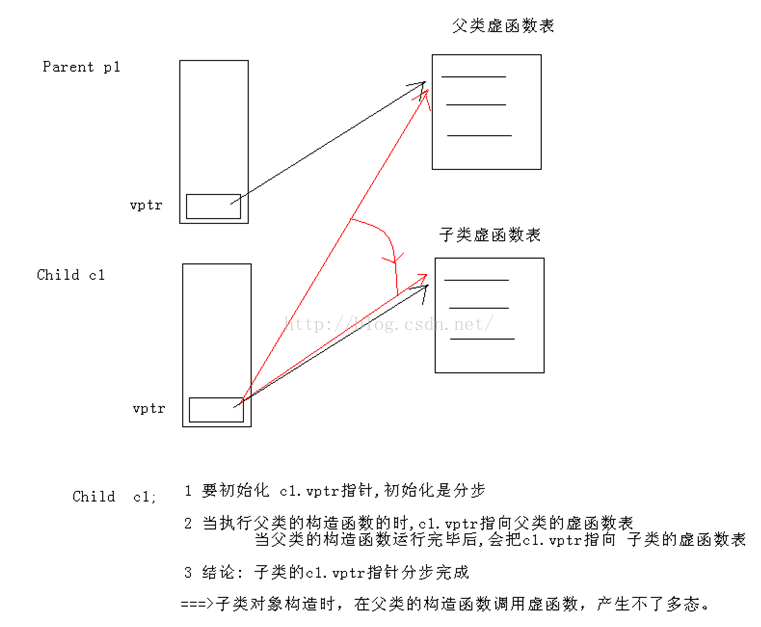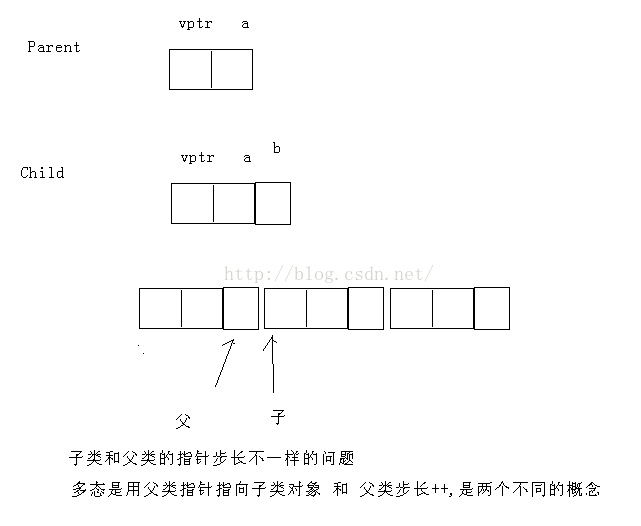
一 构造函数中能调用虚函数,实现多态吗
1)对象中的VPTR指针什么时候被初始化?
对象在创建的时,由编译器对VPTR指针进行初始化
只有当对象的构造完全结束后VPTR的指向才最终确定
父类对象的VPTR指向父类虚函数表
子类对象的VPTR指向子类虚函数表
class Parent
{ public:
Parent(int a=0)//执行时此时的调用的print函数仍然是父类的函数(此时会将vptr指针指向父类的虚函数表)
{
this->a = a;
print();
}
virtual void print()
{
cout<<"我是爹"<<endl;
}
private:
int a;
};
class Child : public Parent
{ public:
Child(int a = 0, int b=0):Parent(a)//先执行父类构造器,执行完之后返回子类(vprt指针指回子类虚函数表)
{
this->b = b;
print();
}
virtual void print()
{
cout<<"我是儿子"<<endl;
}
private:
int b;
};
void HowToPlay(Parent *base)
{
base->print(); //有多态发生 //2 动手脚
}
void main()
{
Child c1; //定义一个子类对象 ,在这个过程中,在父类构造函数中调用虚函数print 能发生多态吗?
system("pause");
return ;
}
二 父类指针步长和子类指针步长不一致时
class Parent
{
public:
Parent(int a=0)
{
this->a = a;
}
virtual void print()
{
cout<<"我是爹"<<endl;
}
private:
int a;
};
//成功 ,一次偶然的成功 ,必然的失败更可怕
class Child : public Parent
{
public:
/*
Child(int a = 0, int b=0):Parent(a)
{
this->b = b;
print();
}
*/
Child(int b = 0):Parent(0)
{
//this->b = b;
}
virtual void print()
{
cout<<"我是儿子"<<endl;
}
private:
//int b;
};
void HowToPlay(Parent *base)
{
base->print(); //有多态发生 //2 动手脚
}
void main()
{
Child c1; //定义一个子类对象 ,在这个过程中,在父类构造函数中调用虚函数print 能发生多态吗?
//c1.print();
Parent *pP = NULL;
Child *pC = NULL;
Child array[] = {Child(1), Child(2), Child(3)};
pP = array;
pC = array;
pP->print();
pC->print(); //多态发生
pP++;
pC++;
pP->print();
pC->print(); //多态发生
pP++;
pC++;
pP->print();
pC->print(); //多态发生
cout<<"hello..."<<endl;
system("pause");
return ;
}
以上就是C++复习要点总结十一——多态(二)的内容,更多相关内容请关注PHP中文网(www.php.cn)!
 Apakah perbezaan antara bahasa c++ dan c
Apakah perbezaan antara bahasa c++ dan c
 Perintah pembelajaran yang disyorkan untuk c++ dan python
Perintah pembelajaran yang disyorkan untuk c++ dan python
 Analisis keberkesanan kos pembelajaran python dan c++
Analisis keberkesanan kos pembelajaran python dan c++
 Adakah bahasa c sama dengan c++?
Adakah bahasa c sama dengan c++?
 Mana yang lebih baik untuk belajar dahulu, bahasa c atau c++?
Mana yang lebih baik untuk belajar dahulu, bahasa c atau c++?
 Perbezaan dan hubungan antara bahasa c dan c++
Perbezaan dan hubungan antara bahasa c dan c++
 Tutorial perubahan bahasa Cina perisian C++
Tutorial perubahan bahasa Cina perisian C++
 Analisis keberkesanan kos pembelajaran python, java dan c++
Analisis keberkesanan kos pembelajaran python, java dan c++




